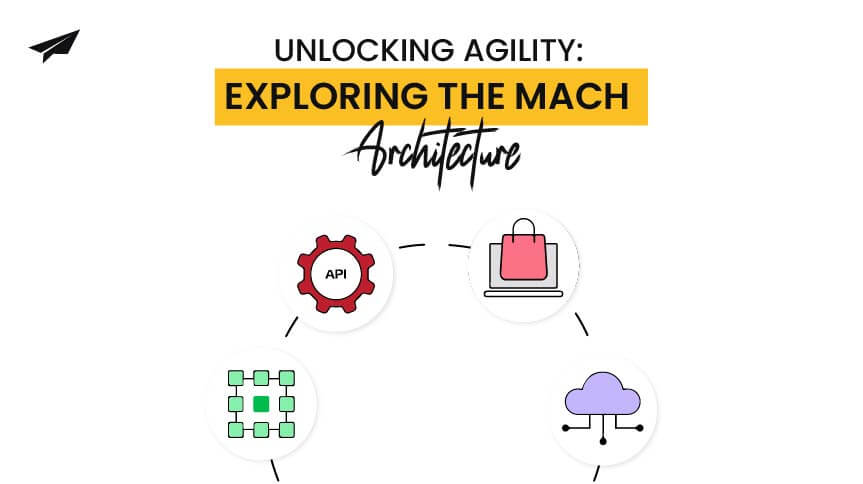Unlocking Agility: Exploring the MACH Architecture
The MACH architecture offers a smart approach to improving business operations. It provides a customized plan for achieving desired outcomes. In today’s rapidly evolving technological landscape, adaptability and proficiency are crucial for businesses to outperform their competitors. This article will brief you about what the MACH architecture is, how it works, some real-life examples of it being used, and all the good things it brings to how we build systems today.
MACH is an acronym representing architectural principles that stand for Microservices, API-first, Cloud-native, and Headless. It embodies a transformative approach to designing and developing digital solutions prioritizing flexibility, scalability, and rapid adaptation. The MACH architecture encourages a modular structure, enabling organizations to break down complex systems into smaller components that can be produced and maintained independently.

Flexible Customization
Its emphasis on flexibility and customization is at the core of the MACH architecture. By adopting a microservices-based approach, businesses can tailor individual services to their unique requirements without affecting the overall system. Different teams can develop each microservice using other programming languages and technologies, promoting innovation and specialized expertise.
How MACH System Architecture Works
The MACH system architecture works as a beacon of innovation in modern system design. But how does this revolutionary approach work? Let’s delve into the mechanics of MACH system architecture and explore how its Microservices, API-first, Cloud-native, and Headless principles come together to shape a new era of flexibility, scalability, and adaptability.

- Microservices: The Building Blocks
At the core of MACH architecture are microservices – independent, self-contained units that encapsulate specific functionalities. These microservices operate as building blocks of an application, allowing developers to focus on crafting individual features or services without the need to understand the entire system. Microservices can be developed, deployed, and maintained separately, promoting efficient collaboration, rapid development cycles, and specialization.
- API-First: Seamlessness in Communication
MACH architecture emphasizes the importance of Application Programming Interfaces (APIs) as communication between different microservices. APIs allow services to interact and exchange data standardized and efficiently. This API-first approach promotes interoperability, enabling organizations to integrate services seamlessly and build cohesive applications that transcend traditional boundaries..
- Cloud-Native: Harnessing the Power of the Cloud
MACH architecture is inherently cloud-native, meaning that it leverages cloud computing capabilities to the fullest. Cloud-native applications are designed to exploit cloud resources, such as automatic scaling, resilience, and cost optimization. This approach minimizes the need for managing traditional infrastructure and allows applications to respond swiftly to changes in demand.
Scalability of MACH
Scalability is a hallmark of the MACH. The microservices model allows businesses to scale individual services independently based on demand. This elasticity is particularly crucial in modern business landscapes, where sudden spikes in user activity can strain traditional systems. With MACH, businesses can scale the most needed components, optimizing resources and enhancing performance.
Cost Efficiency with MACH Architecture
The cost efficiency brought by MACH architecture stems from its cloud-native nature. Traditional monolithic systems often require substantial resources for maintenance, even during periods of low demand. On the other hand, Cloud-native MACH applications can scale down resources when demand decreases, leading to cost savings. Furthermore, the modular structure allows organizations to invest resources in specific services as needed, reducing unnecessary expenditures.
Expansion Of MACH
Expansion is at the heart of the MACH, offering businesses a gateway to boundless possibilities and growth. With its Microservices, API-first, Cloud-native, and Headless principles, MACH lays the foundation for seamless scalability and adaptability, enabling organizations to embrace change and expand their horizons with unparalleled agility. As businesses evolve and customer expectations shift, MACH’s modular microservices allow adding new functionalities or services without disrupting the existing ecosystem. This modular approach ensures that organizations can experiment, innovate, and respond to emerging trends swiftly while maintaining the integrity of their systems. Whether introducing new features, catering to diverse customer needs, or venturing into uncharted territories, MACH empowers businesses to expand their offerings while fostering a culture of innovation that keeps them at the forefront of their industries. By providing a framework that thrives on growth and adaptability, MACH truly unlocks the potential for organizations to explore new dimensions and shape the future of their operations.
Real World Examples of MACH
Here are some compelling real world examples that showcase how MACH architecture is driving innovation, flexibility, and success:
- E-Commerce Reinvented: E-commerce platforms are embracing MACH architecture to create personalized and dynamic shopping experiences. By decoupling the front end (headless) from the back end, these platforms can experiment with various customer interfaces and adapt to rapidly changing market trends. Imagine an online fashion retailer that seamlessly integrates AI-powered recommendations, chatbots for customer service, and an immersive virtual try-on experience. MACH enables these features to function as independent microservices, providing customers with a cohesive and tailor-made journey.
- Seamless Financial Services: The financial sector is utilizing MACH architecture to deliver agile and efficient services. Consider a banking application that offers customers a range of financial products – from loans to investments. Each financial assistance can be developed, updated, and maintained independently with MACH. This means that the loan service can be enhanced with new features without affecting the investment service, enabling institutions to respond to market demands and regulatory changes swiftly.
- Healthcare on Demand: In the healthcare sector, MACH architecture is revolutionizing patient care. Picture a telemedicine platform that provides seamless interactions between patients and healthcare professionals. With MACH, appointment scheduling, virtual consultations, and prescription delivery can be treated as distinct microservices.
This modular approach ensures scalability, privacy compliance, and integration with emerging technologies like wearables and AI-driven diagnostics.
The Future Landscape of MACH Architecture
The MACH architecture is poised to play a pivotal role. It aligns with the demands of today’s advanced world, offering businesses the tools they need to adapt in order to reach their goals when it comes to scalability. It also helps businesses with what they need to change, come up with new ideas, and do really well. The MACH architecture helps organizations be their best by letting them make things just how they want, be ready for big changes, save money, and connect things easily.
Conclusion
In conclusion, the MACH architecture is a testament to the transformative power of flexible, modular, and adaptable design. Through its Microservices, API-first, Cloud-native, and Headless principles, businesses can create systems that are responsive to change and primed for growth. As organizations across industries embrace the advantages of MACH, Tekglide feels the digital landscape is set to witness a new era of agility, innovation, and success.






